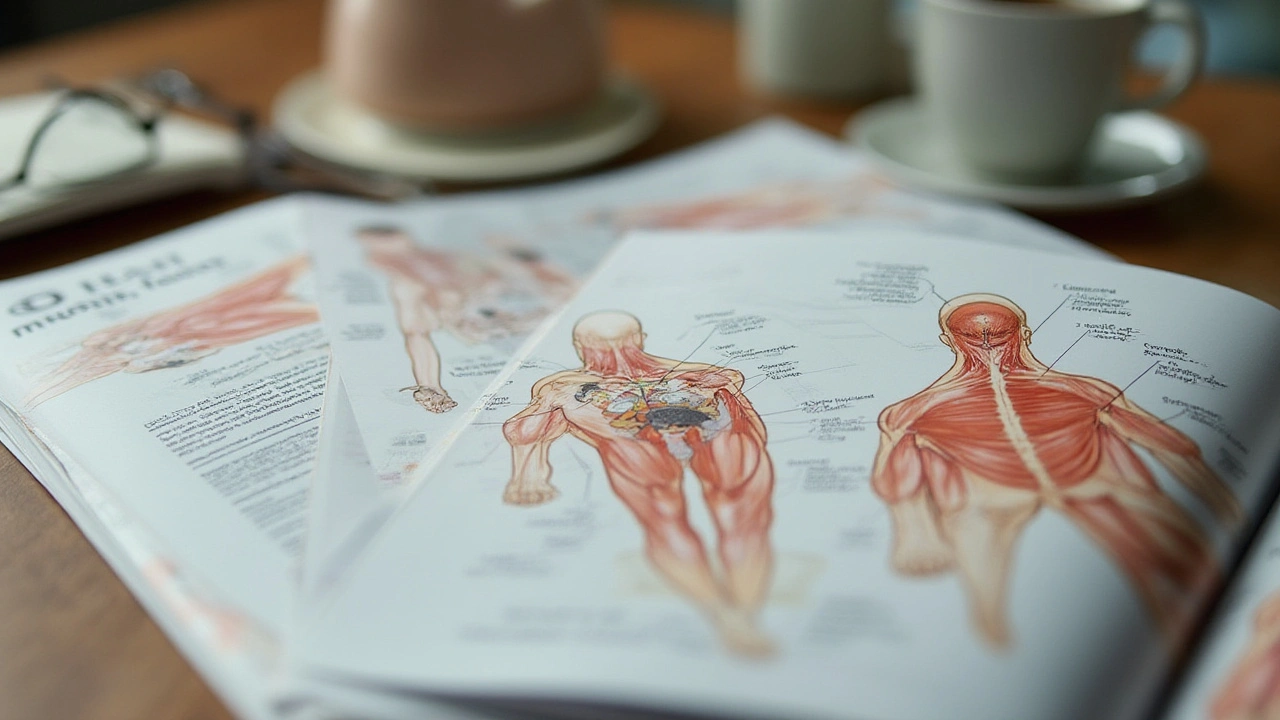Trigger Point Massage for Chronic Pain Relief: How It Works & Why It Matters

Most people think pain is something you just have to put up with. Here’s something wild: more than 70% of chronic pain cases—those stubborn aches that haunt your back, neck, or shoulders—are linked to what experts call trigger points. These aren’t just regular sore spots. They’re tight little knots in your muscles that can shoot pain through your whole body. Some call them ‘muscle landmines.’ But there’s good news: trigger point massage has given countless people their lives back, often after years of prescription meds, fruitless stretching, or fruitless doctor visits. It’s changed my life too, and if you’ve felt stuck and hopeless about your pain, stick around—there’s a reason physical therapists, pro athletes, and pain clinics keep coming back to this technique.
What Are Trigger Points and Why Do They Wreak Havoc?
Picture a muscle as a bundle of fibers, like a handful of spaghetti. When you move, these fibers glide smoothly in sync. But if something throws off the balance—a bad desk chair, a tough workout, a night of sleeping wrong—some fibers bunch up into a tight knot. That knot is your trigger point. Unlike a regular sore muscle, trigger points don’t just ache in one place. They send pain to other parts of your body. For example, a trigger point in your upper back might make your whole arm tingle or give you a pounding headache. The real kicker? You can poke the exact spot in your muscle and make the pain shoot somewhere else. The phenomenon is officially called ‘referred pain.’
A study at the University of Texas in 2022 found that up to 85% of people with stubborn back and neck pain actually had clusters of trigger points as the source. These pain points can form after accidents, from bad posture, heavy lifting, or even from emotional stress. Stress is a biggie—when your brain’s on edge, your muscles tighten up too.
The challenge is that most doctors don’t check for trigger points during routine visits. Some folks spend years chasing diagnoses they don’t have, all while their real pain keeps flaring. The famous researcher Dr. Janet Travell, who mapped out trigger points in the 1960s, showed that people with chronic pain nearly always have a constellation of these knots. Left untreated, they get tighter and spread more pain, draining your energy and messing with your sleep.
The Science Behind Trigger Point Massage
Let’s get real: massaging a trigger point isn’t just about feeling good. There’s real science showing it works. Trigger point massage aims to break up those tight clusters by applying steady, targeted pressure right on the knot. This boosts blood flow, flushes out waste products, and gives your muscle the nudge it needs to finally relax.
Researchers at the Cleveland Clinic ran a clinical study in 2023 that found 62% of chronic pain patients saw at least a 50% drop in their pain after six sessions of trigger point massage (compared to just 12% for folks who got regular Swedish massage). That’s a huge difference. The relief often comes fast—you might feel lighter after one session, or it could take a few weeks for deep knots. The goal is to ‘melt’ the trigger point until it feels more like normal, healthy muscle tissue.
Trauma, overuse, or even dehydration can spark a trigger point. When the tissue gets squeezed, fresh oxygen from the blood can’t get in. Metabolic waste—think of it like muscle garbage—builds up, leading to more pain. That’s why pressing into a knot can make it *hurt*, but this discomfort is actually your body’s healing alarm. When done right, the pressure breaks the cycle. Your muscles start getting fresh blood, and that area stops screaming at you.
Studies suggest that trigger point massage improves flexibility, restores muscle function, and reduces headaches tied to tight neck and shoulder muscles. A big plus: it can slash your need for painkillers.

Spotting and Treating Trigger Points Yourself
If you’re curious whether you have trigger points, here’s a simple test: find a spot on your neck, back, or legs that feels extra tender or hard, almost like a frozen pea under your skin. Press firmly. Does the pain jump or zap to another area? Bingo. That’s a known trigger point.
So, what can you do at home? Grab a tennis ball, lacrosse ball, or even a foam roller. Lean your body against the wall or floor with the ball under the knot and gently press in. Hold the pressure for about 30-90 seconds, then release. You’re looking for a sweet spot where it’s painful but not unbearable—a ‘good pain’ that eases up after a few moments. You’ll probably feel relief, tingling, or warmth spreading out from that spot.
Don’t dig too hard. Aggressive pressure can just make things worse. If you’re not sure, talk to a massage therapist or look up reputable YouTube demonstrations. Give yourself a few days between sessions to let the muscle relax. Drinking water, taking a warm shower, or gentle stretching afterward can help, too.
- Hydrate well after a massage session; it helps flush out toxins released from tight muscles.
- Use slow, steady pressure—aim for deep release, not sharp jabbing.
- Never work on swollen, bruised, or injured areas without medical guidance.
- If a knot causes tingling or intense numbness, see a professional—nerves might be involved.
Pro tip: Trigger points often travel in packs. If you clear out one knot but notice pain in other spots, scan nearby muscle groups and work those, too. The more you practice, the better you’ll get at recognizing your muscle’s 'call for help.'
The Benefits: What Can Trigger Point Massage Really Do?
Let’s talk results, not just theories. Trigger point massage attacks the root cause, so you’re not just masking symptoms. People with chronic headaches say their migraines decrease or vanish. Back pain that’s kept folks from golfing or running often melts away after a month or two of focused work. Even frozen shoulder and sciatica—conditions that push people toward surgery—sometimes respond better to trigger point release than to any other treatment.
One stat that blew my mind: in 2023, a Dutch pain clinic tracked 200 chronic pain patients for a year after getting regular trigger point massage. Nearly 69% said they were able to cut back significantly or fully stop pain meds. More than half went back to regular activities they’d avoided for years. That’s not a fluke—it’s consistent with what therapists see every day.
Folks battling fibromyalgia, tension headaches, or tendonitis all see improvement. For athletes, trigger point work speeds up recovery and keeps injuries from coming back. Office workers chained to their desks finally turn their heads without that annoying popping or stabbing pain. And for older adults, keeping muscles supple can help keep them mobile, prevent falls, and improve their overall quality of life.
Some people notice better sleep, less anxiety, and way more energy after clearing up their knots. It’s not magic or wishful thinking; it’s a simple case of improving how your muscles talk to your brain. The pain that once hijacked your attention finally simmers down.
| Trigger Point Massage Benefits | Reported Improvement Rate (%) |
|---|---|
| Reduction in Chronic Pain | 74 |
| Improved Sleep Quality | 51 |
| Increase in Mobility | 63 |
| Decrease in Pain Medication | 69 |
| Headache Reduction | 57 |
While trigger point massage won’t fix every chronic pain case, it’s clear why so many people call it a ‘lifesaver.’ It addresses deep-rooted pain—often when nothing else comes close.

How to Find the Right Professional and What to Expect
If DIY massage isn’t cutting it, or you want a fresh set of hands, look for a licensed massage therapist trained in trigger point work or myofascial release. Don’t just settle for any spa massage; you want someone who’s legit and has good reviews from people who struggled with issues like yours.
The first session often starts with a quick talk about your pain and lifestyle habits. Wear something comfortable, because the therapist might have you stretch or move as they find problem areas. When they dig into a trigger point, you’ll know—there’s usually a distinct ache or tenderness. The therapist should check in with you, adjusting the pressure so you can handle the sensation without gritting your teeth. Most sessions last around 30 to 60 minutes, and sometimes you’ll feel sore the next day (kind of like after a hard workout). That’s normal—it means your muscles are waking up to new blood and oxygen supply.
Good practitioners will teach you how to manage your pain at home, too. They may suggest stretches, posture tweaks, or hydration tips. Some use tools—like massage sticks or special balls—to go after really deep knots. If you’re seeing no improvement after a few sessions, ask for a referral to a physical therapist or a pain specialist who understands trigger point therapy.
Here’s a checklist for finding the right person:
- Check their certifications—look for ‘trigger point therapy’ or ‘myofascial release’ as specialties.
- Ask about experience with your specific pain issue (back pain, migraines, etc.).
- Find out if they work with physical therapists or pain doctors for stubborn cases.
- Read reviews online, especially from patients who sound like they went through what you’re dealing with.
Trigger point massage shouldn’t be a once-in-a-blue-moon luxury. For chronic pain sufferers, it can be a regular part of self-care and recovery. Stick with it, and your muscles will thank you. You’ll likely get back to the things you love—and maybe even forget about that pain that used to call the shots in your life.





